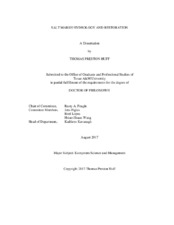| dc.contributor.advisor | Feagin, Rusty A | |
| dc.creator | Huff, Thomas Preston | |
| dc.date.accessioned | 2018-02-05T21:18:59Z | |
| dc.date.available | 2019-08-01T06:54:30Z | |
| dc.date.created | 2017-08 | |
| dc.date.issued | 2017-07-11 | |
| dc.date.submitted | August 2017 | |
| dc.identifier.uri | https://hdl.handle.net/1969.1/165967 | |
| dc.description.abstract | Hydrologic changes have affected coastal ecosystem sustainability along the Texas coast and throughout the Gulf of Mexico. Human utilization of coastal ecosystems has led to the alteration of tidal hydrology. These ecosystems are highly dynamic and are greatly affected by tidal fluctuations and restriction to hydrologic flow.
The main objective of this study was to understand the hydrologic effects of tides, hydrologic alterations, and subsequent restoration on salt marshes along the Texas coast. The selected study site was Magnolia Beach marsh in Matagorda Bay, approximately 10.5 kilometers southeast of Port Lavaca, Texas. The study also had three more specific objectives.
The first objective was to determine the cause of marsh loss observed since 1958. This was accomplished by a GIS analysis that identified over 62 hectares of marsh loss and a hydrologic analysis that identified a pair of tidal barriers. These barriers reduced the volume of water that could be exchanged between the salt marsh and Matagorda Bay. This intermittent connectivity resulted in the internal waters of the marsh becoming hypersaline.
The second objective was to measure the hydrologic response to tidal reconnection with the removal of the two barriers. This was accomplished through the creation of a STELLA computer model, a numerical inlet hydrology model, and a meta-analysis to predict barrier removal success. An analysis of water level and water velocity before and after the barrier removal was used to quantify the success of the hydrologic reconnection.
The final objective was to create a tide prediction model to better estimate wind driven tides. The current NOAA model has been effective to give astronomical tide movements, but is not capable of predicting wind driven tides. The Enhanced Tide Model resulted in a 13.34% average increase in tidal prediction accuracy across all NOAA tidal gauges in the Gulf of Mexico and the East coast of Florida. This tool could be used by the public, the shipping industry, and restoration planners to better understand tide dynamics in the Gulf of Mexico and abroad. | en |
| dc.format.mimetype | application/pdf | |
| dc.language.iso | en | |
| dc.subject | Restoration | en |
| dc.subject | Salt Marsh | en |
| dc.subject | Ecology | en |
| dc.subject | Hydrologic Restoration | en |
| dc.subject | CTD | en |
| dc.subject | Aquadopp | en |
| dc.subject | Hydrology | en |
| dc.subject | Modeling | en |
| dc.subject | Matagorda Bay | en |
| dc.subject | Magnolia Beach | en |
| dc.title | Salt Marsh Hydrology and Restoration | en |
| dc.type | Thesis | en |
| thesis.degree.department | Ecosystem Science and Management | en |
| thesis.degree.discipline | Ecosystem Science and Management | en |
| thesis.degree.grantor | Texas A & M University | en |
| thesis.degree.name | Doctor of Philosophy | en |
| thesis.degree.level | Doctoral | en |
| dc.contributor.committeeMember | Figlus, Jens | |
| dc.contributor.committeeMember | Lopez, Roel | |
| dc.contributor.committeeMember | Wang, Hsiao-Hsuan | |
| dc.type.material | text | en |
| dc.date.updated | 2018-02-05T21:19:00Z | |
| local.embargo.terms | 2019-08-01 | |
| local.etdauthor.orcid | 0000-0002-3248-0358 | |


